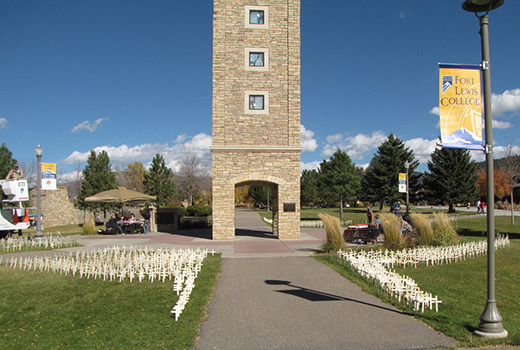EDITOR’S NOTE: For information on Global Hunger Relief, which uses 100 percent of each gift to meet hunger needs, visit globalhungerrelief.com.
Crosses made of paint stir sticks — 19,000 of them — have become a reminder of starving children worldwide to people in southwest Colorado.
Each cross of 12-inch paint stir sticks stapled together and painted white represents one child. Together, 19,000 crosses represent the United Nations estimate of the number children who die daily from hunger and other effects of poverty worldwide.
“The blind spot of the church today is the enormous number of children across the world who are dying each day from hunger and the effects of poverty,” said Gordon Herrick, a member of First Baptist Church in Bayfield, near Durango. Herrick said his conscience was pricked after leading a study of the book “Radical” by David Platt, the International Mission Board’s new president.
Herrick approached Randy Ash, pastor of First Baptist Bayfield, about his belief that if people understood how many children die of poverty-related causes, they would give to Southern Baptists’ Global Hunger Relief (also called the World Hunger Fund) or another organization that tackles hunger-related issues.
“It only takes $1 to feed a child for a day,” Herrick wrote on Facebook.com/crossesproject. “It is estimated that if the contributions to combat world poverty were to increase by just 10 percent of their present levels, the problem could be eradicated in 10 years.”
His idea was to fashion paint stir sticks into white crosses that are temporarily “planted” in visible places around southwestern Colorado to let people see just how many 19,000 is.
“The Lord laid it on my heart to demonstrate this enormous problem that’s totally preventable,” Herrick told Baptist Press in a telephone interview. “We didn’t want to put a guilt trip on people, but to get them to think about what they could do.”
With the enthusiastic approval of his pastor — Ash says part of his calling is “If you have a passion for ministry, let me help you fulfill it” — Herrick gathered about 10 people from the church to make some 750 crosses during a 90-minute, once-a-month Saturday “project day.”
With a local hardware store — Lewis Mercantile — matching one-for-one the cost of the paint stir sticks, First Baptist can get 500 for about $30. Herrick estimated the total cost of stapling one-half of a paint stick horizontally to a full-length vertical stick and painting one side white to be about $3,000 for 19,000 crosses.
However, he learned from experience that the crosses, although gleaming brightly at first in contrast to the surrounding ground, lose their visibility as they become weathered and must be continually replaced.
Another problem is manpower. It’s back-breaking work even with crowbars beating holes in the ground to plant several thousand crosses at a time. A three-hour workday is about all an adult past the flexibility of youth can endure, Herrick said.
“We do what we can,” Herrick said. “We feel we’re being obedient to what we’re called to do….
“Thirty years ago, 43,000 children died each day from hunger and poverty,” Herrick said, quoting, he explained, statistics from the relief organization Compassion International.
“Now we have it down to 19,000,” he said. “We believe that’s still too big a number and hope we can reduce that to zero within the next 10 years. If we can realize 10 percent more contributions over the next 10 years, the death of all these children can be completely eradicated.”
The first display of the crosses was in July 2013 at the city-owned ski slope not far from downtown Durango, some 15 miles west of Bayfield. A month-long permit was received from the city, and about 30 members of the church where about 120 attend Sunday morning worship used crowbars to make holes in the rocky ground for 4,500 crosses that had been made to that point. The crosses stretched up the ski slope, ultimately making the form of a cross.
Some people objected to what they saw as a religious display on city-owned property, and overnight July 9-10 the crosses “went missing.” No trace of them has been found; none in nearby shrubbery; none piled high or stuffed into trash sacks. The crosses and their disappearance made their way into the Durango Herald’s “letters to the editor” section for two months, Pastor Ash said.
“It was disappointing on several levels,” Herrick said about the disappearance of the crosses, the pain of the missing symbols still evident in his voice a year later. “Why wouldn’t somebody want to help starving children?”
First Baptist members gathered to make more crosses, and by October had completed 4,000 to be placed at Durango’s Fort Lewis College in concentric circles around a clock tower in a project with Master Plan Ministries, a student organization.
“We are committed to praying over each cross individually,” Herrick said. “We think that might be the most important part, for God’s people to be praying God’s heart. We believe it sets that cross apart and represents a child that day.”
At Easter the crosses were displayed on the lawn at First Baptist in Bayfield, located at a main intersection in the town of about 1,600. This summer they were planted in a quarter-acre section of the pastor’s property on highway frontage just inside the Durango city limits. This October they are again set up at Fort Lewis College.
Mission teams looking for a week-end project are invited to participate in First Bayfield’s “planting parties.” Contact Herrick at Facebook.com/CrossesProject or the church at fbcbayfield@qwestoffice.net.
“One of the spinoff benefits is non-Christians seeing people doing something Christ-like,” Herrick said. “We’re serious Christians. We’re not just in it [church] only until it costs us something.”

